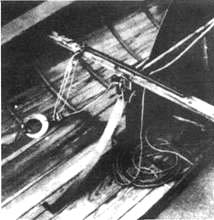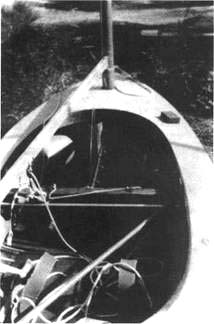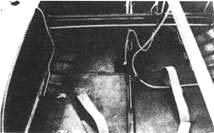| 23. History of the Finn Rules |
by Peter Mohilla and Richard Hart |
|
The objective of this chapter is to document the history of the written rules governing the design of the Finn up to the present standard.
|
1949
In contrast to the other participants of the design competition in 1949, Rickard Sarby took a different approach. The other contestants designed a boat on paper and wrote a description. Sarby built a boat with very little design work on paper. Of this three dimensional model he made a survey and traced his ideas backward to produce the plans. And finally the concept of the dinghy was expressed in addition in words. Plans and a description were produced to fulfil the requirements of the competition. Thus the oldest remaining written statement about the Finn is the description of the 'FIN' from 1949 which Rickard Sarby handed over to the Finnish Yachting Association as part of his entry to the design competition.
|
 |
| The building of the first Finn in 1949. Rickard Sarby in centre behind the boat. |
|
This document lists verbally the material and the dimensions of each part of the boat S 1, which the Sarby brothers had actually built already. It can not be called a set of rules, but it was the beginning of the Finn Rules which control the boat up to the present time. The only restrictive information regarded the weight. The hull had to have 100 kg, fully rigged the boat was supposed to weight 150 kg. The mast had to be 9 kg. Despite the fact, that Sarby's 'FIN' was not at all successful in the competition, had only limited success in the trial races of 1949, and that Rickard was very skeptical that 'FIN' would become the Olympic monotype, a large number of Swedish amateurs showed keen interest to build such a dinghy in the winter 1949/50. For their information Sarby handed out the plans and the description of the 'FIN' to them. Thus the material served as an instrument of guidance rather than of control. About 25 boats were built in Sweden in that winter 1949/50. The 'FIN' description of 1949 includes detailed instructions for the diagonal double carvel planking only. No alternative building method is considered.
1950
An improved version of this description exists from early 1950 for the dinghy under the new name of 'FINT'. After the successful trial races in May 1950 the Finnish Yachting Association decided to adopt 'FINT' as the Olympic monotype for 1952, and to change the name to 'FINN'. Rickard Sarby handed over all rights of the Finn to the Finnish Yachting Association who in turn passed them on to the Scandinavian Yachting Union. As early as September 1950 this authority published the first formal collection of written rules in Swedish.
This document is of a mixed nature. It states that the dinghy is to be built in accordance with the drawings and the written specifications. These specifications generally include possible materials and dimensions, sometimes adding optional alternatives and including only a few restrictive statements. The document does not always clearly specify whether the dimensions are minimum or maximum, and whether the boat remains within the class or not, if certain dimensions are changed, if components are omitted or added, or if different construction methods are used. Some items were left to the discretion of the National Authorities to decide, so the rales did not even attempt to be international.
This first set of rules from September 1950 included rules for carvel planking only. No alternative building method is mentioned. It is left open whether any other method would be legal. A special section lists a few measurements to which the dinghy must adhere to in order to qualify as a Finn. Measuring of a Finn in those days required the control of only 20 dimensions and three weights. The hull was controlled at station 0/2/4/6 only and not at station 8. Each builder or measurer could produce for himself the templates for station control and these were derived from a table of offsets which accompanied the drawings. The mast was measured not from the keel outside of the boat, but from the deck with the mast in its normal position in the boat. The mast rake was required to be 50/1000. A special arrangement to prevent the mast leaving the step was optional. To require this was left to the discretion of the National Authorities. There was no requirement for any buoyancy. Sailors were even penalised for this item, since any buoyancy bags had to be taken out for weight control and tanks were not allowed. Windows in the sails were not allowed. It might be of further interest, that the position of the mast hole and the centreboard pivot bolt were not specifically controlled by a measurement, and neither was the projection of the centreboard.
|
1951
In 1951 the Scandinavian Yachting Union printed these rales with a few additions. This set of regulations specified that the dinghy was to be built in accordance with 5 drawings and 23 written specifications. It was not yet quite clear, whether a boat qualified as a Finn if some of the items were changed in size, omitted or other parts not mentioned added. There were 5 special regulations for racing the dinghy (one person, arrangements extending outboard and loose ballast prohibited, paddle, bailer and 2 painters on board, four holds optional). The incisive regulations in addition to the more informative 23 specifications mentioned above remained unchanged from the 1950 version.
The most important change in this printed version of 1951, against the set of typewritten rales of 1950, was that two different methods of constructing the hull were allowed. In case of the conventional single carvel planking the number of frames had to be in conformity with the drawings.
|
 |
| A Finn in 1951 |
|
If the planking was of glued double diagonal carvel (as Rickard Sarby had built his first prototype S 1) or ribboned carvel glued, or if the planking was made of thin stripes of plywood glued together, every second timber could be left out. This printed version of 1951 was made available to interested National Authorities together with a set of plans, in order to construct some Finn Dinghies for the preparation of sailors for the 1952 Olympic Games.
1952
In 1952 the organiser of the Olympic Regatta issued a few more rales, which may or may not be considered as binding for the class in the following years. These rules banned mechanical devices as bailers, which nowadays every Finn has. To adjust the angle between mast and boom only pieces of wood or paper in the boom slot of the mast were allowed, but no vangs.
Loose footed main sails were prohibited, which appeared once again more than 20 years later - to be banned again. It was specifically mentioned, that the head of the paddle may be cut off, so that the paddle can serve as emergency tiller. During the Olympic Races Paul Elvstrom asked for permission to introduce a relatively small device to serve the function of the present traveller. The original boats had both blocks firmly attached in the centre of the dinghy. The Committee granted Paul to use a wire, which allowed the front block to move about 20 cm to the lee, which many other competitors considered to have been an unfair advantage for the Gold Medal winner.
This was the first incidence of a sailors finding a hole in the rales in order to be faster than his competitors. In the case of the traveller it took 28 years before a rale was approved limiting the movement of the mainsheet block at 550 mm from the centreline and not more than 150 mm in front of station 4.
|
1953
There was rather limited interest in the further development of the Finn in 1953 and no rule changes are known from this year.
1954
However by 1954 it became obvious to the Scandinavian Yachting Union that a number of new constructions of questionable legality had come up. So a first Technical Committee of experienced Finn sailors was formed, consisting of Elvstrom from Denmark, Skaugen from Norway, Finell from Finland, and Sarby from Sweden. However the honourable members of the Scandinavian Yachting Union - people who never had sailed a Finn did not trust these young hotshots and changed some of their decisions after the committee had published its findings, creating quite a confusion among the active Finn sailors and the organisers of the 1956 Olympic regattas in Australia .
|
 |
| One of the early plastic Finns |
|
The Elvstrom - Sarby Committee suggested to change the measurement of the mast (formerly from the deck) quite logically from the keel (as it is now the rale). But the SYU Committee decided to take all measures from the plane of the gunwale (sheer height) which was very difficult to measure and no improvement over measuring from the deck. Because of improved technology the Australians wanted to construct the 1956 Olympic Finns in hot moulded plywood, which was not allowed before but approved by the Scandinavian Yachting Union in 1954. This allowed the exclusion of the frames completely. The rules were amended accordingly.
1955
By 1955 pressure from outside the Scandinavian countries increased, especially from Belgium and France, to hand over the administration of the Finn and the measurement rules to the IYRU and to form an International Finn Association. After some resistance the Scandinavian Yachting Union cooperated and handed over a set of rales to the IYRU at the end of 1955. This set stated in the beginning, that "the aim of the class rales is to create a real One Design Class and they should be interpreted in that spirit". For clarification it was expressed for the first time, that "the dimensions of the materials are nominal but not binding, unless expressly pointed out".
|
The amendments in accordance with the Australian Olympic Finns are included in this version of 1955. Of interest might be, that suction bailers were allowed and buoyancy bags were strongly recommended but not yet required. However any buoyancy had to be removed for the control of the hull (105 kg) and the overall (145 kg) weight. Thus sailors using any safety equipment were penalised. In this 1955 version the hull shape had to be controlled also at station 8 for the first time. From that time on, the mast was measured outside of the boat from the keel. There was no regulation controlling the centre of gravity in 1955. The only requirement in this sense was that half of any necessary additional lead was to be fastened to the underside of the deck in front of station 8 and half astern of station 1.
By 1955 a special set of rules had been developed in the United Kingdom. They generally followed the 1955 version of the Scandinavian Yachting Union. The most significant difference is the requirement to have buoyancy bags. Two units of 45 kg buoyancy were necessary. A few more changes were included in response to the rough sailing conditions in England with sometimes strong wind, high and consequently low tides.
In a letter dated September 1955 Richard Murray, Chairman of the British Finn Association, found, that the rules of the Scandinavian Yachting Union were not precise enough. He felt that the form giving dimensions should be changed to either minimum or maximum. Murray remarked, that some of the British Finns have hollow waterlines at station 8, because that section was not controlled at the time.
|
 |
| Andre Nelis' Finn in 1957 |
|
1956
In 1956 the international Finn Association IFA was formed and acknowledged by the International Yacht Racing Union (IYRU). The rules of 1955 by the Scandinavian Yachting Union mentioned above were reissued without any substantial changes by the International Finn Association in 1956. The only alteration was that disputes regarding the interpretation of these rules had to be referred to the IFA and not any longer to the Scandinavian Yachting Union. From that time on the official language of the Finn Class was not Swedish but English. The first AGM of the IFA in 1956 also elected the first Technical Committee of the IFA, consisting of Rickard Sarby as the chairman and Richard Murray and B. Dotsch as members.
|
1957
At its AGM in 1957, the newly founded IFA decided upon a number of rule changes and gained its first sobering experiences when the IYRU refused to confirm most of them. The most significant concerned the limitation of the fully lowered centreboard to 700 mm to the keel band. In 1957 the Finn Class was already discussing the possibility of introducing Dacron Sails and Fibreglass Hulls, but did not yet propose this to the IYRU.
|
 |
Paul Elvstrom's Finn in 1957 |
|
|